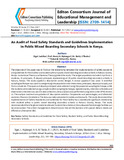An Audit of Food Safety Standards and Guidelines Implementation in Public Mixed Boarding Secondary Schools in Kenya.

View/
Date
2021-11Author
Jackline, Sigei
Henry K., Kiplangat
Betty J., Tikoko
Metadata
Show full item recordAbstract
The objective of this paper was to find out the relationship between the implementation of safety standards
and guidelines for food safety and student safety in public mixed boarding secondary schools in Nakuru County,
Kenya. Invitational Theory and Systems Theory guided the study. The target population included 2130 Form 4
students, 16 principals, 18 deputy principals representing all 16 public mixed boarding secondary schools in
Nakuru, Kenya. The study applied a descriptive survey design. A census approach was used. A stratified
sampling technique was used in categorising the population into three strata; principals, deputy principals, and
Form 4 students. Principals and deputy principals were selected using the purposive sampling technique, while
the students were selected using a simple random sampling technique. Questionnaires, interview schedules and
observation checklist was used in data collection. Data analysis was performed using tools in the SPSS version
22. The analysis involved computation of descriptive statistics: frequencies and percentages, and inferential
statistics: Pearson Correlation. The data was later presented in tables and textually. The study discovered that
implementation of Safety Standards and Guidelines for Food Safety has a statistically significant relationship
with student safety in public mixed boarding secondary schools in Nakuru County, Kenya. The study
recommended that the government to allocate funds to the schools so that adequate food storage facilities can
be constructed. The school management should ensure that all the learners with special dietary needs are
offered an alternative diet.
